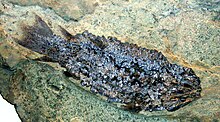Eusthenopteron
This article may be too technical for most readers to understand. (February 2018) |
| Eusthenopteron Temporal range: Late Devonian,
| |
|---|---|

| |
| Life restoration of Eusthenopteron foordi | |
| Scientific classification | |
| Domain: | Eukaryota |
| Kingdom: | Animalia |
| Phylum: | Chordata |
| Clade: | Sarcopterygii |
| Clade: | Tetrapodomorpha |
| Clade: | Eotetrapodiformes |
| Family: | †Tristichopteridae |
| Genus: | †Eusthenopteron Whiteaves, 1881 |
| Species[1] | |
| |
Eusthenopteron (from Greek: εὖ eû, 'good', Greek: σθένος sthénos, 'strength', and Greek: πτερόν pteron 'wing' or 'fin')[2] is a genus of prehistoric sarcopterygian (often called "lobe-finned") fish known from several species that lived during the Late Devonian period, about 385 million years ago. It has attained an iconic status from its close relationship to tetrapods. Early depictions of animals of this genus show them emerging onto land, but paleontologists now think that eusthenopteron species were strictly aquatic animals, though this is not completely known.[3]
The genus was first described by J. F. Whiteaves in 1881, as part of a large collection of fishes from Miguasha, Quebec, Canada.[4] Some 2,000 Eusthenopteron specimens have been collected from Miguasha, one of which was the object of intensely detailed study and several papers by paleoichthyologist Erik Jarvik between the 1940s and the 1990s.[5]
Description
[edit]Eusthenopteron is a medium- to large-sized tristichopterid. The species E. foordi is estimated to have exceeded 1.5 m (4 ft 11 in) in length, while the species E. jenkinsi probably reached 2.1 m (6 ft 11 in).[6][1] Eusthenopteron may have weighed around 50 kilograms.[7]

The earliest known fossilized evidence of bone marrow has been found in Eusthenopteron, which may be the origin of bone marrow in tetrapods.[8]

Eusthenopteron shares many unique features among fishes but in common with the earliest-known tetrapods. It shares a similar pattern of skull roofing bones with stem tetrapoda forms such as Ichthyostega and Acanthostega. Eusthenopteron, like other tetrapodomorph fishes, had internal nostrils (or a choana), one of the defining traits of tetrapodomorphs, including tetrapods. It also had labyrinthodont teeth, characterized by infolded enamel, which characterizes all of the earliest known tetrapods as well.
Unlike the early tetrapods, Eusthenopteron did not have larval gills.[9]
Classification
[edit]
Like other fish-like sarcopterygians, Eusthenopteron possessed a two-part cranium, which hinged at mid-length along an intracranial joint. Eusthenopteron's notoriety comes from the pattern of its fin endoskeleton, which bears a distinct humerus, ulna, and radius in the fore-fin and femur, tibia, and fibula in the pelvic fin. These appendicular long bones had epiphyseal growth plates that allowed substantial longitudinal growth through endochondral ossification, as in tetrapod long bones.[10] These six appendicular bones also occur in tetrapods and are a synapomorphy of a large clade of sarcopterygians, possibly Tetrapodomorpha (the humerus and femur are present in all sarcopterygians). Similarly, its elasmoid scales lack superficial odontodes composed of dentine and enamel; this loss appears to be a synapomorphy with more crownward tetrapodomorphs.[11] Eusthenopteron differs significantly from some later Carboniferous tetrapods in the apparent absence of a recognized larval stage and a definitive metamorphosis.[6] In even the smallest known specimen of Eusthenopteron foordi, with a length of 29 millimetres (1.1 in), the lepidotrichia cover all of the fins, which does not happen until after metamorphosis in genera like Polydon (the American paddlefish). This might indicate that Eusthenopteron developed directly, with the hatchling already attaining the adult's general body form (Cote et al., 2002).

See also
[edit]References
[edit]- ^ a b Downs, Jason P.; Daeschler, Edward B.; Long, Alison M.; Shubin, Neil H. (2018). "Eusthenopteron jenkinsi sp. nov. (Sarcopterygii, Tristichopteridae) from the Upper Devonian of Nunavut, Canada, and a Review of Eusthenopteron Taxonomy". Breviora. 562 (1): 1–24. doi:10.3099/mcz44.1. ISSN 0006-9698. S2CID 51883892.
- ^ Miller, S. A. (Samuel Almond) (1889). North American geology and palæontology for the use of amateurs, students, and scientists. Cincinnati, O. : [Western Methodist book concern]. p. 597. Retrieved 6 January 2022.
- ^ M. Laurin, F. J. Meunier, D. Germain, and M. Lemoine 2007. A microanatomical and histological study of the paired fin skeleton of the Devonian sarcopterygian Eusthenopteron foordi. Journal of Paleontology 81: 143–153.
- ^ Whiteaves, Joseph Frederick (1881). "On some remarkable fossil fishes from the Devonian rocks of Scaumenac Bay, in the Province of Quebec". Annals and Magazine of Natural History. 8 (44): 159–162. doi:10.1080/00222938109487434.
- ^ Geological Survey of Canada (7 February 2008). "Past lives: Chronicles of Canadian Paleontology: Eusthenopteron - the Prince of Miguasha". Archived from the original on 11 December 2004. Retrieved 10 February 2009.
- ^ a b Schultze, H.-P. 1984. Juvenile specimens of Eusthenopteron foordi Whiteaves, 1881 (Osteolepiform rhipidistian, Pisces) from the Late Devonian of Miguasha, Quebec, Canada. Journal of Vertebrate Paleontology 4: 1-16.
- ^ Dinosaurier-Freilichtmuseum und Naturdenkmal Dinosaurierfährten Münchehagen (2012). Museumsführer [Museum guide] (1st ed.). Rehburg-Loccum, Münchehagen: Nationaler Geotop, National Geographic Society. p. 16.
- ^ Sanchez S, Tafforeau P and Ahlberg P E (2014) "The humerus of Eusthenopteron: a puzzling organization presaging the establishment of tetrapod limb bone marrow" Proceedings of the Royal Society B: Biological Sciences, 281 (1782): 20140299. doi:10.1098/rspb.2014.0299
- ^ Amphibian evolution : the life of early land vertebrates (page 141)
- ^ M. Laurin, F. and J. Meunier 2012. A microanatomical and histological study of the fin long bones of the Devonian sarcopterygian Eusthenopteron foordi. Acta Zoologica 93: 88–97.
- ^ Zylberberg, L., Meunier, F. J. and Laurin, M. 2010. A microanatomical and histological study of the postcranial dermal skeleton in the Devonian sarcopterygian Eusthenopteron foordi. Acta Palaeontologica Polonica 55: 459–470.








